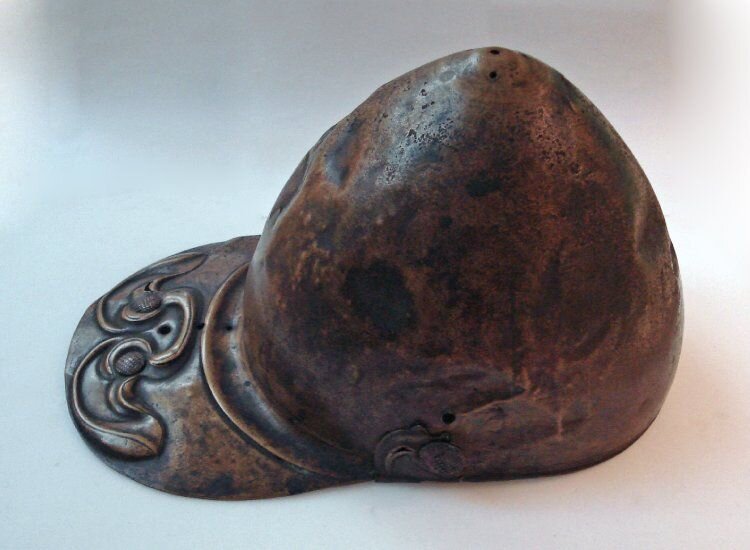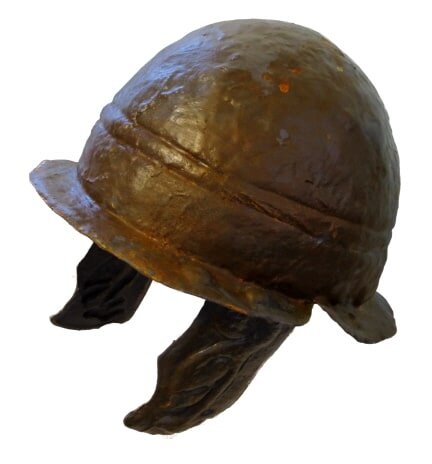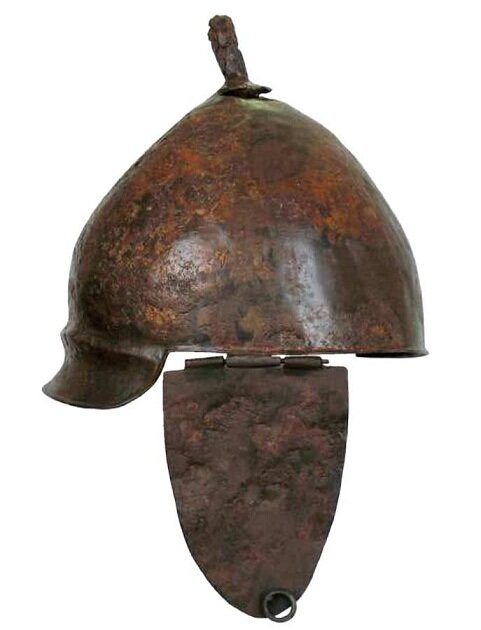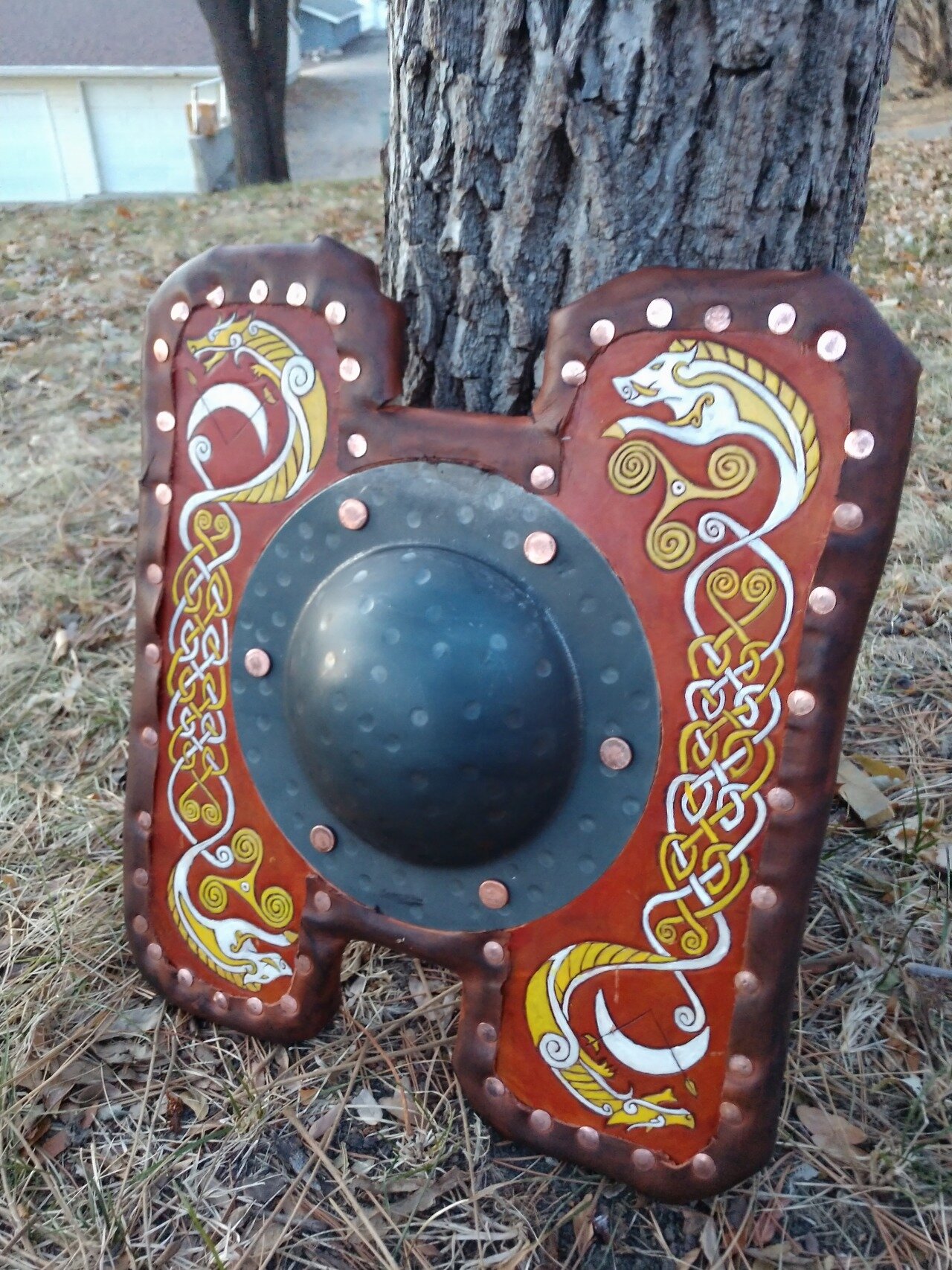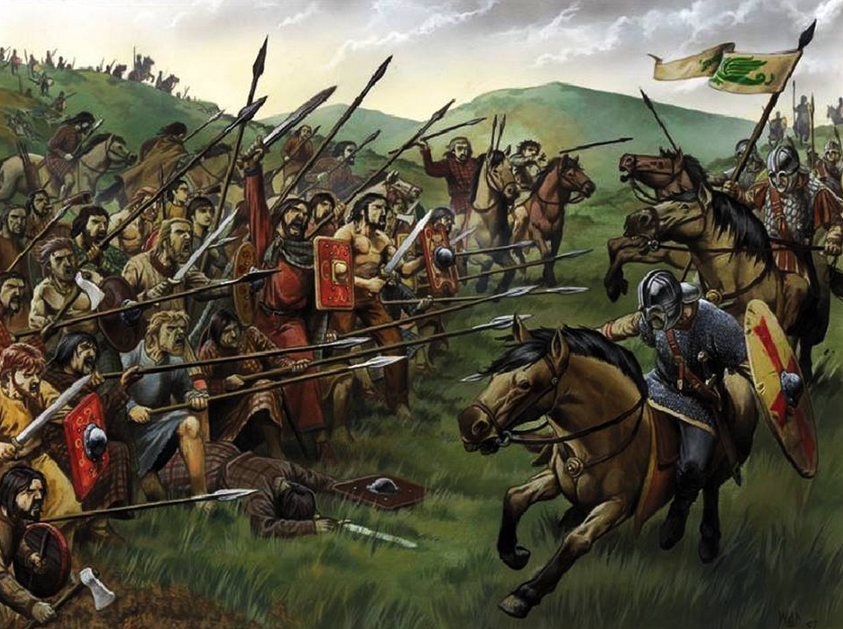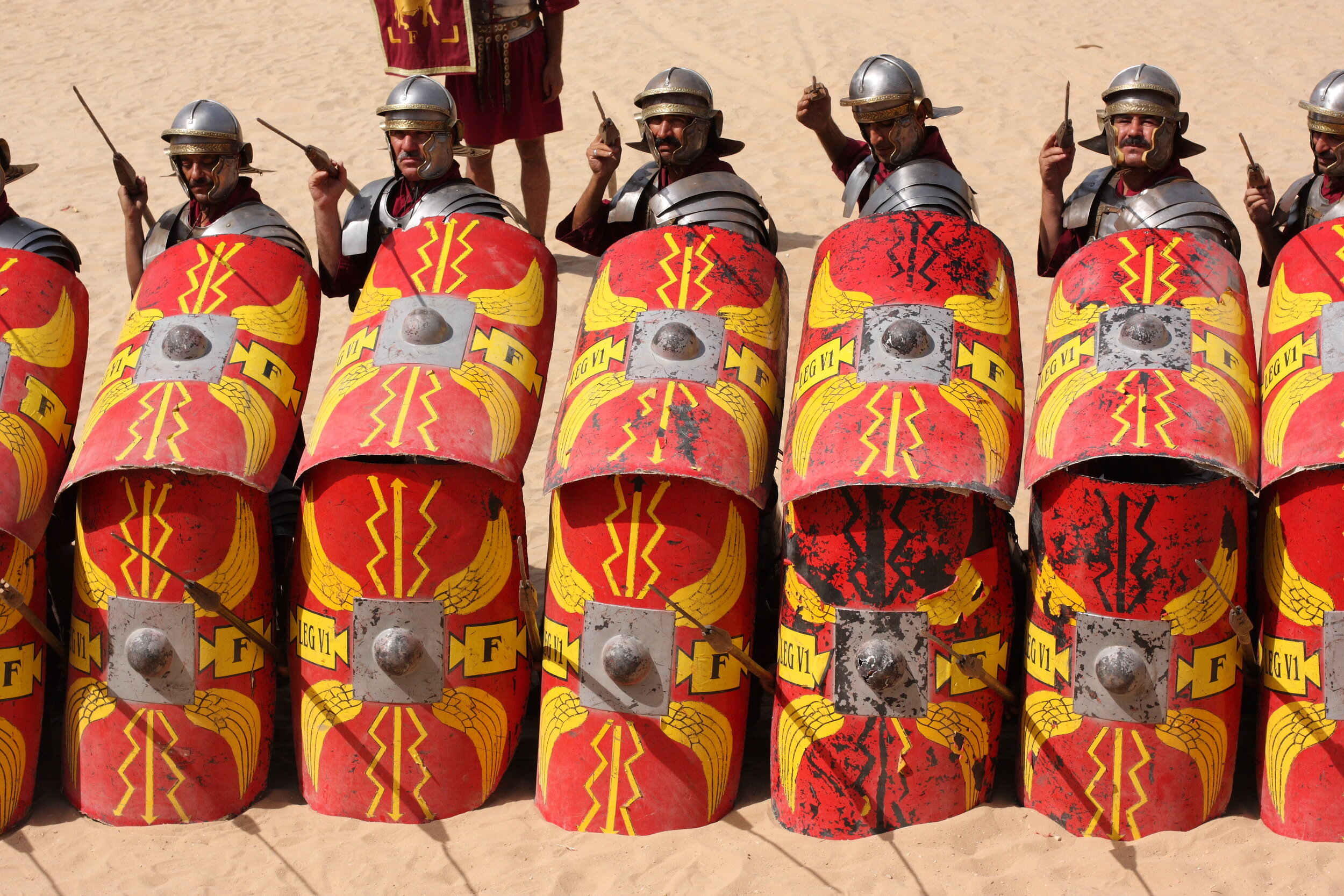Armour
Celtic Bronze helmet
Period: 200 BC
Along with the development of more efficient weapons came better personal armour. Early head protection came from simple leather helmets. Bronze helmets provided much better protection from sword and spear strokes and the designs developed to include front peaks and side guards to protect the ears and cheeks.
The helmet has a dome of beaten bronze with a bronze peak embossed with a celtic symbol design.
Hinged side flaps protect the ears and include ornamentation and inlaid semi-precious stones.
The helmet also includes a cast dome ornamentation and is lined with a hessian band to make the wearer more comfortable.
Pict Helmet
Period: 400 AD
Knowledge of the personal armour of the Picts comes from fragments found locally.
A helmet or bascinet was widely used during this period and the designs were similar across Europe and the Roman Empire. Much of the armour was looted from the Romans and the Britons or copied from contemporary designs.
The helmet is constructed of polished iron. The crown is strengthened by four additional bars and is assembled with bronze rivets.
The views of the helmet show a reinforced nose guard, the flaps protecting the ear and cheek, a neck guard to the rear and a strengthening rim above the brow.
Viking Helmet
Period: 700 AD
The myth that Viking helmets were fitted with horns is much debated. They would have adopted similar construction techniques known over northern Europe at the time, including the use of bone and horn strengthening. The styles changed considerably, adding or improving protective features such as the "Spectacle" face guard illustrated here.
The Viking Helmet strength comes from the iron cruciform structure. The sections are filled with stout leather panels, though beaten metal or bone panels were also used.
The Spectacle face plate gave protection to the face, nose and eyes and a thick leather flap attached to the rear provided protection to the neck.
Bascinet Helmet
Period: 1300 AD
There was much experimentation with helmet design in Medieval times. The Bascinet helmet developed the armoured cap to enclose the ears and the side of the face.
The helmet was enhanced with a chain mail extension called an "aventail" laced into the loops around the lower reinforcement of the helmet.
The Bascinet is formed from sheets of beaten iron with seams at the front and rear.
The loops for suspension of the aventail provide support for chain mail covering the neck and shoulders.
A padded cap would be worn under the bascinet to make the wearer more comfortable.
The “Great Helm” Helmet
Period: 1400 AD
The development of the helmet naturally progressed to the point where the whole head and face were enclosed.
This round capped construction is known as the "Great Helm". It is likely that William Wallace and his higher ranking commander would have been wearing such a helmet in battle.
The Great Helm is constructed from shaped sheets of iron riveted into a cylindrical shape.
The top is capped and the lower plate covering the mouth is slotted or pierced to allow the wearer to breath.
The front of the helmet is reinforced by a brass cruciform across the nose and eye slot.
A padded helmet cap would be worn inside and a chain mail aventail attached below to protect the neck, shoulders and upper body.
Steill Bonnet
Period: 1650 AD
As the use of firearms increased, body armour proved ineffective as a defence. Musket balls easily penetrated mail and plate armour.
Heavy armour was also an impediment to the legendary highland charge.
One item that was considered essential for the trooper was a steel cap or "steill bonnet".
The Steel Cap shown is constructed of shaped iron plates. The plates are assembled with rivets and a strengthening bead added to the upper seam.
The helmet is fastened with a simple leather strap and a padded leather cap is used to make the wearer more comfortable.
Celtic Shield
Period: 100 BC
Length: 1.2 metres / 48”
Celtic warriors used their shields both as a defensive and an offensive weapon. Examples of 1.0m and up to 1.4m have been found. Shields for warfare were generally of wooden construction but intricately decorated ceremonial bronze and inlaid examples have also been found.
The shield is constructed of oak planks, bound with embossed and painted leather.
Lime was also used to produce a light and resilient protection.
The long oval shield has a central handle to hold securely and use to give a blow to the opponent.
The hand is protected by a bronze boss set into the centre of the shield.
Pict H-Shield
Period: 600 AD
Length: 40 cm / 16”
There are few surviving Pictish relics but rare images from the period such as the Sarcophagus found in St Andrews in 1833 and the Book of Kells give an insight into the weapons of the Picts. The H-Shield is a distinctive shape associated with the Picts, though small, handheld shields of round and square shapes are also in evidence.
The H-Shaped shield is light and compact with a central punch grip. The wooden construction is covered with leather and stained with symbolic figures. A bound wooden frame creates the H-Shape.
The central boss of beaten iron encloses the grip hole and is raised to protect the hand.
Pictish Buckler Shield
Period: 750 AD
Length: 40 cm / 16”
The Pictish warrior fought with a distinctive small shield or buckler. Pictish carvings indicate that these were round, square and H shaped. The buckler is hand held and would be used as an offensive striking weapon in close hand to hand combat.
The buckler is constructed from oak planks covered with embossed leather.
The ornamentation depicts animals and the Picts used images of both real and mystical animals.
Roman Shield
Period: 200 AD
Length: 80 cm / 32”
The Roman Shield or Scutum carried by the infantry was rectangular with a curved surface to adapt it to the shape of the upper body.
The shield was held on the left arm by means of a handle, and covered the left shoulder.
Shields used in parade were intricately decorated but it is unlikely they would have featured in the Scottish campaign.
This Roman Scutum is linen covered and has a large brass boss for hand protection.
The core is made of layered wood with protective thick leather outer, and each shield was individually hand painted.
The design on the shield would represent the colours of the legion.
Highland Targe
Period: 1700 AD
Diameter: 40 cm / 16”
The Highland Targe was the battle shield popular with highland foot soldiers.
It was used as protection against sword blows and spears.
The Targe could also be used as an offensive weapon when fitted with a central spike.
Many different designs can be found with some highly decorative examples from later periods.
The Highland Targe is constructed from oak planks. It is covered with tooled and embossed leather and decorated with brass studs. The central boss is fitted with a removable spike for us in battle. The Targe is held with a wooden hand grip and a leather arm loop for additional security.


